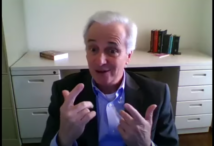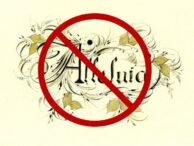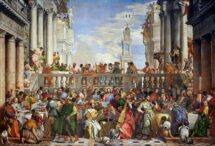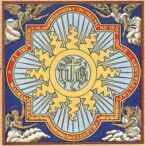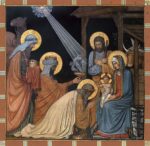If you’re new to Tradition, this video is for you! In the inaugural episode, you’ll learn: -The importance of postures and gestures -When and how to bow -How to fold your hands (yes, there is a right and wrong way) -How to do the sign of the cross -How and when to strike your breast And more. Join us for a fun and instructive conversation!
SEPTUAGESIMA SUNDAY: Grace Notes: Why we sing what we sing
We make our plans, and God makes His. It was God’s plan that our vising priest would have laryngitis for Septuagesima Sunday. Father sheepishly slinked into the Schola practice room before Mass and asked in a whisper if it would be okay if we did not sing that day. It was okay.
I will tell you our considerations, then tell you what we did for the low Mass.
The joyful seasons of Christmas and Epiphany being behind us, we will soon enter the penitential season of Lent. The 3-week season of Septuagesima bridges the gap between the Christmas season and Lent. We now leave behind the joyful Gloria, and the joyful word, Alleluia. The Gloria will be sung on Holy Thursday, and feast days, but the Alleluia will be strictly avoided until the Mass of the Paschal Vigil. So, of course, we will refrain from singing hymns that contain the word Alleluia.
Recall our rule of thumb that if the priest is wearing green, we will often sing Mass XI. There is another rule of thumb: If the priest is wearing purple, we will usually sing Mass XVII. But it would be premature to sing Mass XVII during Septuagesima because Mass XVII is to be used for Lent and Advent. The book that gives us much guidance regarding the Liturgy, the Liber Usualis, doesn’t give us an option for the commons, prescribing Mass XI. So, we have the interesting case where the priest is wearing purple, but had we sung, we would have sung Mass XI – and of course, we would have sung it without its Gloria. We would have paired Mass XVII with Credo I, as usual. But we didn’t sing the Mass. We did, however, sing hymns.
The hymns we choose during Septuagesima will generally have a penitential character, but we still have much to celebrate. So, as the processional we sang Immaculate Mary (with the Lourdes refrain) in honor of Our Lady of Lourdes, which feast we celebrated last week.
At the Offertory, again, we sang Stella Coeli Extirpavit. It is coming on two years since we first started singing it to ask Our Lady to preserve us from the current pestilence.
At the Communion, we sang Parce Domine, omitting the fourth verse owing to the specific reference to the fasting of Lent. We also sang the seasonal Compline Marian anthem, Ave Regina Coelorum.
We concluded with God of Mercy and Compassion, which has a certain penitential feel to it without being full-on Lenten.
FIFTH SUNDAY AFTER EPIPHANY: Grace Notes: Why we sing what we sing
This is the final Sunday in the season of Epiphanytide. The season of Christmastide ended earlier in the week on February 2nd with the feast of the Purification. This feast occurs precisely 40 days after Christmas because, according to the Mosaic Law, a woman must go to the temple to be purified 40 days after the birth of a son (80 for a daughter).
This is also the feast of the Presentation of the Child Jesus in the Temple, Candlemas, and Groundhog Day.
Wait! Groundhog Day? Yes, indeed. And it is not a coincidence. Candle processions on February 2nd were customary in ancient Rome to mark the midpoint between the solstice and the equinox. These were effectively Christianized and associated with the Christian holy day of the Purification and Presentation.
Meanwhile, a folk custom developed throughout Europe of predicting the weather on Candlemas. Generally, if Candlemas were sunny, that would presage a longer winter. The German lore would observe the following.
Sonnt sich der Dachs in der Lichtmeßwoche, so geht er auf vier Wochen wieder zu Loche.
If the badger sunbathes during Candlemas-week, for four more weeks he will be back in his hole.
German immigrants brought the custom into Pennsylvania, though they adopted the indigenous groundhog in place of the badger.
Similar proverbs exist in all European countries and many other countries throughout the world. This is one of several variations from England:
If Candlemas be fair and bright, Come winter, have another flight. If Candlemas bring clouds and rain, Go winter, and come not again.
Every Italian village and town seems to have its own version. One that is common in Rome:
Per la santa Candelora se nevica o se plora dell’inverno semo fora.
For the feast of Candlemas, if it snows or rains, we’re done with winter.
Because Candlemas had occurred earlier in the week, we had the possibility to solemnize the feast and celebrate that Mass in lieu of the Sunday. This would have included the blessing of candles and a candle procession before Mass. We chose not to do so because this was the Sunday on which we also have our Holy Name Society observances. We sang the Mass of the Fifth Sunday after Epiphany, the propers of which come from the Third Sunday after Epiphany.
Father was wearing green – an indication that this was an ordinary Sunday, not a feast, and so we sang Mass XI (for Sundays Throughout the Year) and Credo I.
For the processional, we sang God of Mercy and Compassion with a mind toward upcoming Septuagesima and Lent. At the Offertory, we did our usual Stella Coeli Extirpavit.
For the Communion, we did Jesu Dulcis Memoria, and for the recessional, we sang We Stand for God, both in honor of the Holy Name.
Since we had the feast of Saint Blaise earlier in the week, after Mass, Father blessed throats, during which time we sang the Magnificat, and the mixed Choir sang Alma Redemptoris Mater. Normally it is not so fitting to sing this Marian Anthem outside of Christmastide. We did so due to what would take place subsequently, the blessing of candles, which would normally take place on Candlemas. As is done after the blessing, we sang Lumen ad Revelationem Gentium.
Now you know why there exist candle holders like the one shown in the image.
FOURTH SUNDAY AFTER EPIPHANY: Grace Notes: Why we sing what we sing
Usually, we have important liturgical reasons for picking what we will sing. Sometimes there are other and lesser motives!
We are presently in the season of Epiphany tide, which occurs within Christmastide. The fourth Sunday after Epiphany is a Second-Class feast. For such a feast, the priest wears green, and typically, we would do Mass XI (for Sundays throughout the Year). Instead, we chose to do Mass VIII (for Second Class Feasts). Why so? Simply because one of the Faithful who has a particular interest in the music graciously requested it! It is certainly fitting, liturgically, and we seldom sing it. It is a very beautiful Mass, but unfortunately, it is badly overdone – in many chapels it seems to be the only Mass that is ever sung. We tend to avoid it.
Typically, we would sing Credo III with Mass VIII, and that is what we had in mind. Which leads to another of the various motives behind what we choose to sing. Even though we had intended to sing Credo III, we ended up singing Credo I. Why so? We messed up and intoned the wrong Credo! The poor congregation were trying to understand why what we were singing did not line up with what was on the hymn board. Mea culpa!
The propers we sang were the same this week as they were last week. We will sing the same ones next week as well. Why is that? Recall from our discussion on the Sundays after Pentecost that the number of Sundays after Epiphany varies from as few as 1 to as many as 6. This year we will have 5. You will also remember that the total number of Sundays after Epiphany and after Pentecost will always total to 29 – and so there will be 24 Sundays after Pentecost this year. This, of course, is due to the fact that the better part of the Liturgical year is based on the date of Easter which can vary by as many as 5 weeks. Thus, the propers for the 3rd Sunday after Epiphany are repeated as many times as necessary just as the propers for the 23rd Sunday after Pentecost are repeated as many times as necessary.
The accompanying illustration shows the various possibilities for the number of Sundays after Epiphany and Pentecost. Note that this year there will not be a need to move a Mass (readings and propers) from the time after Epiphany to the time after Pentecost.
We moved our habitual Stella Coeli Extirpavit to before Mass to allow us time for a hymn at offertory.
We gave Christmastide one last gasp as the season comes to an end this coming week on the Feast of the Purification – precisely 40 days after Christmas. We sang Good Christian Men Rejoice as the Processional, Puer Natus in Bethlehem at the Communion, and Angels we have Hear on High as the Recessional.
Given that January is the month in honor of the Holy Name of Jesus, at the Offertory, we sang the vespers hymns from the Feast of the Holy Name, Jesu Dulcis Memoria.
As a meditative piece, after the recessional, we sang Alma Redemptoris Mater, the Marian anthem from Compline that is sung during Christmastide.
SECOND SUNDAY AFTER EPIPHANY: Grace Notes: Why we sing what we sing
Sometimes, things don’t go according to plan. We had snow the night before the Mass and the roads were icy so the church was practically empty. We managed to muster enough men to sing the Mass, but couldn’t marshal a full complement of servers so we had to settle for a low Mass.
We did sing some of the same hymns that we would have sung had we had a sung Mass.
- Processional: O Come all ye Faithful
- Offertory: Stella Coeli Extirpavit
- Recessional: Good Christian Men Rejoice
And had we had a sung Mass, we would also have sung:
- Commons: Mass XI with Credo I
- Propers: From the feast
An interesting aside: The Communion antiphon is particularly long for this mass and has within it what is doubtless the most interesting musical phrase in the entire Gregorian repertoire. It occurs at that point where the wine steward exclaims: Thou hast saved the best wine until now! You can hear the excitement in his voice!
Listen to it here: https://youtu.be/lyXbC8V7oug?t=51
FEAST OF THE MOST HOLY NAME OF JESUS: Grace Notes: Why we sing what we sing
This feast is only a second-class feast, but for those of us in the Holy Name Society, this is a big day.
The men of the Holy Name Society entered the church behind our banner in the procession of the clergy as we sang the Processional, O Come all ye Faithful.
Most of the men then occupied the first two pews in the church. Those of us in the Schola proceeded to the back from where we sing.
The propers we sang were for the feast.
The Commons, in keeping with the glorious Christmas season were from Mass II and Credo III.
All of the joy of the day was somewhat muted at the Offertory as we once again sang Stella Coeli Extirpavit, imploring Our Lady to obtain for us relief from the current pestilence.
At the Communion, we sang the Vespers hymn from the same Feast of the Holy Name, Jesu Dulcis Memoria.
To conclude, we sang the Holy Name Anthem (We Stand for God) for the recessional.
FEAST OF THE HOLY FAMILY: Grace Notes: Why we sing what we sing
The Feast of the Holy Family is a Second-class Feast. Earlier in the week, we had the Feast of the Epiphany which is, of course a First-class Feast and a Holy Day of Obligation. We certainly could have solemnized the Epiphany and Father could have said that Mass instead of the Mass for the Feast of the Holy Family. It is discretionary, but we chose, rather, to celebrate the feast of the day (Holy Family) owing to the importance of the family and the need to pray for families during these times when the very idea of the family is under attack.
Thus, for the Propers, we sang those of the Feast of the Holy Family.
For the Commons, still deep in the Christmas season, we chose Mass II and Credo III.
For the Processional, we sang Good Christian Men Rejoice.
And of course, at the Offertory, Stella Coeli Extirpavit.which we have been doing now for almost two years.
At the Communion, we managed six of the fourteen verses of Puer Natus in Bethlehem.
To close, we paid our homage to the three sainted Magi Kings, Gaspar, Melchior and Balthazar, with We Three Kings.
FOURTH SUNDAY OF ADVENT: Grace Notes: Why we sing what we sing
As you can imagine, a lot of thought goes into planning the music for the Mass, and it all must get done beforehand so that you can be sure everyone will be prepared.
We had everything planned out for Fourth Sunday of Advent.
Well, sometimes, things don’t go according to plan. COVID and various other things hit our singers pretty hard, and we ended up with something extremely rare for us – a Mass completely without music!
THIRD SUNDAY AFTER EPIPHANY: Grace Notes: Why we sing what we sing
We are presently in the season of Epiphanytide, which occurs within Christmastide. The Third Sunday after Epiphany is a Second-Class feast. For such a feast, the priest wears green, and that typically would call for Mass IV (for Ordinary Feasts) or perhaps Mass XI (for Sundays throughout the Year). Wanting to hold on to the Christmas spirit just a little longer, we went with the more glorious Mass II.
Our processional hymn was very much about the joy of Christmas, Good Christian Men Rejoice.
At the Offertory, once again, we sang Stella Coeli Extirpavit, imploring Our Lady to obtain for us relief from the current pestilence. We will soon move this to be sung after the Mass.
At the Communion, we had time to sing eight (of the fourteen) verses of the tender Puer Natus In Bethlehem.
For the recessional, we sang the utterly delightful little tale, Noël Nouvelet, a very loose English translation of a French carol from the end of the 15th century.
As a more meditative piece, after the recessional, we sang Resonet in Laudibus, a Gregorian Christmas hymn, from the 14th century.
THIRD SUNDAY OF ADVENT (GAUDETE): Grace Notes: Why we sing what we sing
Today, known as Gaudete Sunday (because Gaudete is the first word of today’s Introit), is one of only two days during the year when the priest wears rose-colored vestments – the other being Laetere Sunday, during Lent. Normally, the organ is not used during Advent and Lent, but it is permitted on these same two days, Gaudete Sunday and Laetere Sunday.
The use of rose-colored vestments also signals the use of Mass XVII (for the Sundays of Advent and Lent). There are two versions of the Kyrie for Mass XVII. We typically will sing the first version during Advent and the second version during Lent. Of course, there is no Gloria. We paired the Kyriale with Credo I.
Our first consideration in choosing hymns for the day is the liturgical season, which, of course, is Advent. English-language hymns are not permitted during a sung Mass but they are permitted for the processional and recessional (neither of which is during the Mass), so we sang O come, O come, Emmanuel as the processional.
At the Offertory, yet again, we sang Stella Coeli Extirpavit, imploring Our Lady to obtain for us relief from the current pestilence. We will soon move this to be sung after the Mass.
We also managed to fit in but a single verse of Rorate Coeli Desuper. The title of this hymn is from the opening words of Isaiah 45:8:
Rorate coeli desuper et nubes pluant justum. Aperiatur terra et germinet salvatorem.
Drop down dew, ye heavens, from above, and let the clouds rain the just. Let the earth be opened and send forth a Saviour.
The text is used frequently both at Mass and in the Divine Office during Advent. It occurs daily as the versicle and response at Vespers.
At the Communion, the mixed choir sang Sancta et Immaculata. This is a polyphonic rendering of the sixth responsory from Matins of Christmas. The Schola will sing the Gregorian setting at Matins.
The Feast of the Immaculate Conception occurred earlier in the week, so we concluded with Immaculate Mary as the recessional.
